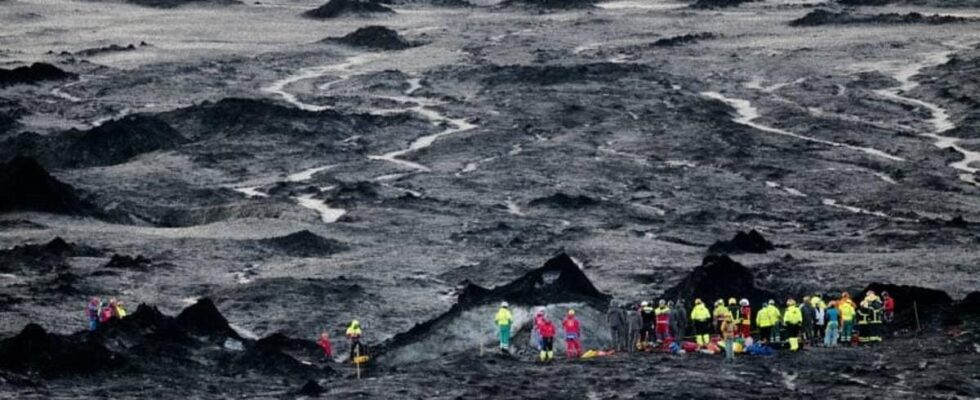One person died and another was seriously injured when the ice cave collapsed. Two people are still missing. On the night of Monday, the search for the missing was put on hold because it was too dark and dangerous to continue. Early on Monday morning, the rescue operation started again, writes the broadcaster RUV. Between 50 and 60 people are on site looking for the missing tourists. The search is very demanding. It is not safe to use machines so they have to dig by hand. The rescue team is divided into three, who dig and search for an hour each. – All this has to be done by hand, more or less. We have saws and wedges and things like that to break up the ice, but nothing else, says police chief in South Iceland Sveinn Kristján Rúnarsson to the Icelandic online newspaper Visir. Rescue workers in Iceland at the ice cave that collapsed. Photo: Ragnar Axelsson No names of the missing It was on Sunday evening that the ice masses crashed over a group of tourists who were on a trip to the ice cave near the Breiðamerkurjökull glacier. It is a glacier arm in the eastern part of Iceland’s largest glacier, Vatnajökull, in southeast Iceland. There were 25 tourists in the group. Most were outside the cave when the accident happened, but four were hit by the ice that collapsed. Two of them were taken out on Sunday evening. One was pronounced dead at the scene. The other was taken to hospital in Reykjavík with serious injuries. The condition must be stable. The police said on Sunday that they have not had contact with the two people who are missing. The police are also not sure of the identity of the two. When asked if they have been in contact with the families of the missing, police chief Sveinn Kristján Rúnarsson replied that they do not have complete information about who they are looking for. Rúnarsson says there is not a complete list of the names of the tourists who made up the tour group, but that they are now going through all registrations. Those who were part of the affected tour group must have been from different countries. Drone image Photo: Guðmundur Bergkvist / RÚV Others heard the landslide Other tourists who had just visited the ice cave told RUV that they heard the sound of the landslide, but that they thought nothing more of it until they saw the news later in the day. They say that the ice cave was relatively small. With a depth of between 3 and 5 metres. The tourist had taken these photos of the ice cave and the surrounding area earlier in the day: Photo: Tipser / RUV Photo: Tipser / RUV Photo: Tipser / RUV Vatnajökull is Iceland’s largest glacier. Most of the glacier is between 1000 and 2000 meters above sea level. Ice caves, or ice caves, are formed when water digs its way through the glacier. Previous fatalities on the glaciers in Iceland Previous fatalities on the glaciers in Iceland 1. Vatnajökull, December 2019: A tourist died after falling into a crevasse on Vatnajökull. This happened at the popular tourist site Skaftafell, where many visitors take guided tours on the glacier. 2. Langjökull, July 2020: A glacier trip by snowmobile ended dramatically when a tourist fell into a hidden crevasse. The tourist was stuck, but was rescued without serious injuries. 3. Sólheimajökull, January 2018: An American tourist died after falling into a crevasse on Sólheimajökull. He was on a guided tour when the accident happened. A “cathedral” in the ice – The ice is like a tough mass. Because of gravity, the ice moves slowly downwards towards the lowlands in various valley depressions, says the Norwegian geologist Børge Johannes Wigum, who lives in Iceland. PHOTO TAKEN ON THE SAME DAY: A tourist who visited the ice cave earlier today took this photo. Photo: Tipser / RUV These parts of the glacier are called glacier arms. They are constantly in motion. – Ice caves are formed when water flows through the ice. Then you get beautiful, rounded formations in the ice. When there is no water in the caves anymore, it is popular to take tourists there, explains Wigum. He has himself visited ice caves in Iceland. Geologist Børge Johannes Wigum lives in Iceland himself, and has visited such ice caves. – It is spectacular. It is crystalline, glassy ice. The ice caves can be tens of meters high and wide. It’s like a cathedral inside the ice, says Wigum. The geologist emphasizes that he does not know what has happened to this ice cave, and that he is speaking on a general basis. Do not think Norwegians are affected The Ministry of Foreign Affairs tells NTB they are aware of the ice cave collapse on the Breiðamerkurjökull glacier. – So far we have received no information that suggests that Norwegian citizens are affected, says communications advisor Ragnhild Håland Simenstad to the news agency. Published 25/08/2024, at 18.49 Updated 26.08.2024, at 16.34
ttn-69
Ice cave collapsed in Iceland – tourist died – news Urix – Foreign news and documentaries

